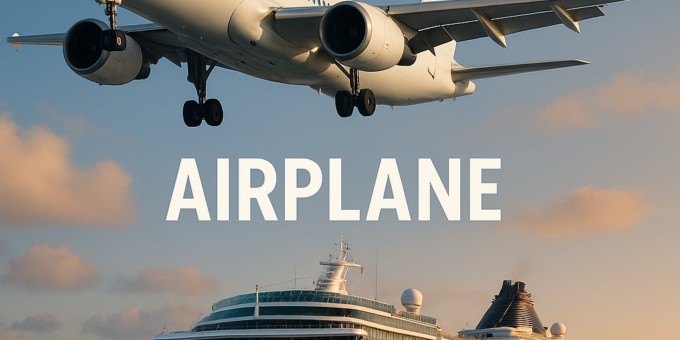
In today’s interconnected world, the urge to travel and explore new places has become more than just a luxury—it’s a lifestyle. Whether you’re jetting off to Tokyo in under 12 hours or spending a week cruising through the Caribbean, the best ways to travel the world now offer more options than ever before. Yet, when it comes down to choosing between airplanes and luxury cruises, travelers are often divided. Both modes have evolved significantly over the decades, each offering distinct advantages tailored to unique travel styles.
Whether you’re a solo adventurer, a couple seeking romance, or a family on holiday, this comparison will help you make an informed decision. Let’s take flight or set sail as we explore the intricacies of both.
Airplane vs Luxury Cruise Comparison
The decision between airplane and luxury cruise depends heavily on personal preferences, purpose, time constraints, and budget. Airplanes are designed for speed, allowing you to reach far-off places in record time. Meanwhile, luxury cruises redefine the journey itself, offering an experience that’s as memorable as the destinations.
In the sections ahead, we’ll weigh each travel mode across categories such as cost, comfort, environmental impact, and cultural immersion—helping you decide the best way to travel the world.
Air Travel: The Fast Lane
Flying has become synonymous with modern travel. With over 100,000 flights globally per day, airplanes are the preferred mode for those seeking speed and convenience. Whether it’s a 2-hour domestic flight or a 15-hour transcontinental route, airlines deliver connectivity that’s tough to beat.
Aircraft have undergone massive upgrades over the last decade—faster engines, quieter cabins, more fuel-efficient systems, and improved safety protocols. Today’s premium cabins offer reclining lie-flat beds, private suites, and onboard showers on select routes.
Yet, even with all its glory, flying isn’t always glamorous. The stress of layovers, security checks, and turbulence can be overwhelming. Still, if reaching your destination swiftly is a priority, air travel takes the lead.
Luxury Cruise: Sailing in Style
On the other end of the travel spectrum lies the majestic world of luxury cruises. Think of them as floating five-star resorts, complete with world-class dining, Broadway-style shows, spas, fitness centers, and even art auctions.
Cruise lines like Seabourn, Regent Seven Seas, and Silversea have transformed sea travel into an all-inclusive vacation. Cabins range from cozy ocean-view suites to lavish penthouses with butlers and private verandas.
Cruises allow travelers to explore multiple destinations without the hassle of constant packing. It’s a slower, more intentional form of travel—perfect for those who savor the journey as much as the destination.
Airplane: Pros and Cons
Pros:
-
Fast and efficient for long distances
-
Broad route network
-
Ideal for business or time-sensitive travel
-
Extensive flight frequency
Cons:
-
Strict baggage limits
-
Little opportunity for sightseeing en route
-
Jet lag and altitude discomfort
-
Airport security delays
Luxury Cruise: Pros and Cons
Pros:
-
All-inclusive luxury
-
Multiple destinations in one trip
-
Entertainment, dining, and wellness onboard
-
Stress-free boarding
Cons:
-
Slower pace
-
Expensive for short-term travel
-
Limited port durations
-
Sea sickness for sensitive travelers
Cost Comparison
When comparing the best ways to travel the world, cost is often a deciding factor. At first glance, airplane tickets may seem more budget-friendly—especially when booked early or using loyalty miles. However, hidden expenses like checked baggage, seat selection, airport meals, and transport from the airport can significantly inflate the final cost.
Luxury cruises, conversely, operate on a mostly all-inclusive model. While the upfront ticket price may be higher, it usually includes accommodation, meals, entertainment, and sometimes even excursions. For example, a 7-day Mediterranean cruise might cost $3,000 per person, but that includes gourmet dining, world-class shows, fitness facilities, and stops in several countries.
Time Efficiency
When every second counts, flying is the undisputed champion. A direct flight from New York to London takes about 7 hours, while crossing the Atlantic by cruise ship takes around 7 days. Airplanes are ideal for travelers needing to maximize their time at the destination.
Cruises embrace a different philosophy. The journey is the experience. For retirees, honeymooners, and slow travelers, spending time aboard a vessel moving between ports is part of the appeal.
That said, cruise itineraries are often well-planned, ensuring minimal wasted time. Ports are chosen strategically, excursions are curated, and travelers rarely need to arrange logistics independently.
Verdict: Need to be somewhere fast? Go airborne. Craving the scenic route? Set sail.
Environmental Impact
Sustainability is a hot-button issue in the travel world. According to the International Air Transport Association (IATA), airplanes are responsible for about 2–3% of global CO₂ emissions. The high-altitude emissions make their environmental impact more severe.
Cruise ships, particularly older models, have also faced scrutiny for emissions, waste disposal, and marine disruption. However, newer ships now include eco-friendly technologies like LNG fuels, advanced water purification systems, and solar-powered amenities.
Environmental Tips:
-
Fly direct to reduce fuel burn from take-offs and landings.
-
Choose airlines that invest in carbon offset programs.
-
Opt for modern cruise liners with environmental certifications.
Ultimately, both methods have work to do on the sustainability front, but progress is happening on both sides.
Safety Considerations
While both air and sea travel are statistically among the safest forms of transportation, perception often paints a different picture. Airplane crashes, though rare, receive massive media coverage, which can induce fear. Cruise incidents, such as outbreaks or rare mechanical failures, tend to get less sensationalized but can still impact perception.
Air travel benefits from rigorous international safety standards, real-time radar, and constant monitoring. Turbulence may be unsettling, but planes are built to withstand extreme conditions.
Cruises also follow strict maritime laws and safety drills are mandatory before departure. Most ships are equipped with medical centers, evacuation procedures, and trained staff. However, in the event of a major emergency at sea, assistance may not be as immediate as on land.
Tip: Always read travel insurance fine print—some policies treat cruise travel as a special category.
Luggage and Baggage Flexibility
Air travel often comes with tight luggage restrictions. Most economy travelers are limited to one carry-on and one checked bag, with extra baggage costing hefty fees. Liquid restrictions and TSA rules further complicate packing.
Cruise ships, however, are much more relaxed. You can typically bring multiple large suitcases without worry. This flexibility makes cruises ideal for longer trips or those who prefer packing formal wear, sports gear, or luxury items.
Pro tip: If you love traveling with everything from hiking boots to cocktail attire, cruises are a dream.
Accessibility for Seniors and Disabled
Accessibility has become a major focus in the travel industry, and both airplanes and cruises have made significant strides. Airplanes provide wheelchair access, priority boarding, and onboard assistance. However, navigating large airports, security lines, and narrow airplane aisles can be daunting.
Cruise ships, by contrast, are far more senior- and mobility-friendly. Elevators, wide hallways, mobility scooter rentals, and accessible cabins are standard. Staff are trained to assist, and the slower pace suits many seniors perfectly.
For disabled travelers, modern cruise ships are practically floating accessible resorts.
Cultural Immersion Opportunities
Flying allows you to land directly in the heart of local culture. You can spend days exploring a city’s streets, markets, museums, and restaurants. Each day offers the chance to delve deeper into a destination.
Cruises, on the other hand, offer shorter, curated glimpses. Ports of call last anywhere from 8 to 24 hours, limiting the depth of your exploration. However, many cruises hire local guides and offer cultural excursions to provide authentic insights.
Bottom Line: If cultural immersion is your primary goal, air travel allows for more independent, in-depth exploration.
Food and Dining Experiences
The battle of the bites is a close one. Airlines have improved their culinary game, particularly in business and first class where gourmet meals are crafted by celebrity chefs. However, economy meals still leave much to be desired.
Cruises shine in the dining department. Buffet spreads, à la carte gourmet restaurants, 24-hour room service, and even cooking classes are common. From sushi to steaks, the variety is astounding. Plus, it’s all part of your fare.
Foodies, rejoice—cruise dining is often an adventure of its own.
Entertainment and Leisure
In-flight entertainment has come a long way: touchscreen monitors, latest blockbusters, music, and games. Yet, it’s mostly passive.
Cruises, on the other hand, are a playground. Think Broadway shows, comedy clubs, casino nights, silent discos, magic acts, cooking classes, and dance lessons. There’s even zip-lining and rock climbing on some mega-ships!
Summary: Airplanes offer distraction. Cruises deliver a full-blown festival.
You Can Also Read : Battery Life Tips: Make Your iPhone or Android Last Longer Between Charges
Sleeping Comfort
Overnight flights rarely offer restful sleep—unless you’re in business class with lie-flat seats. Turbulence, dry air, and cramped space don’t help.
Cruise cabins range from cozy interior rooms to lavish suites with private balconies. Beds are full-size, the cabin is quiet, and you’re gently rocked to sleep by the ocean. Sleeping at sea feels closer to being in a luxury hotel than traveling.
Sleep Tip: If comfort is king, the cruise wins this round.
